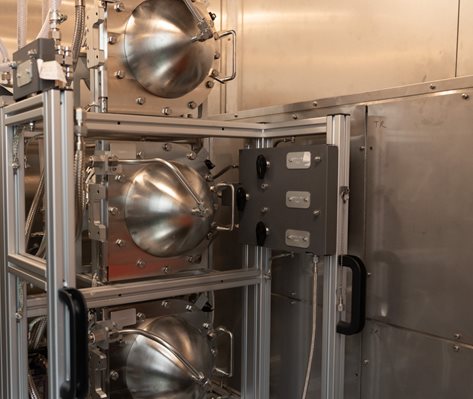Developing advanced technology to validate the performance of low-cost sensors
In recent years, there have been significant advances in how air quality is monitored, with the development of low-cost sensors. These miniaturised monitors are often substantially cheaper than traditional technologies and are not limited by the constraints of traditional reference instruments remaining at fixed locations.
We have developed a unique type testing facility, the multiple atmosphere controlled environment (MACE). This is used for evaluating the performance of low-cost sensors and assisting industry, academia and other customers in developing new products to meet the monitoring requirements of air quality legislation.

A wide range of atmospheric and environmental parameters can be generated, controlled and monitored in the advanced purpose-built exposure chambers. These are developed to meet the type testing requirements defined in documentary standards that underpin UK and European environmental legislation. The facility has been designed to accommodate sensors measuring the regulated compounds nitrogen dioxide, ozone, carbon monoxide, sulphur dioxide, together with other pollutants including carbon dioxide and ammonia.
NPL is also involved in the development of a Technical Specification (TS) for low cost sensors within CEN TC264 WG42. CEN/TS 17660‑1:2021.
‘Air quality – Performance evaluation of air quality sensor systems – Gaseous pollutants in ambient air’ has been published and a TS covering particles is nearing completion. NPL has also developed a UK Publicly Available Specification (PAS) for Defra through the British Standards Institute (BSI) - Selection, deployment and quality control of low-cost air quality sensor systems in outdoor ambient air – Code of practice.
Validating the performance of low-cost passive and diffusive samplers for air quality monitoring
We have developed a controlled atmosphere test facility (CATFAC) to evaluate and validate the performance of passive and active sorbent-based samplers used for air quality (AQ) monitoring.
The CATFAC can accommodate atmospheres of target air pollutants at known concentrations under well-defined environmental conditions of temperature, relative humidity and wind speed. Sensors under test can be placed within the system for extensive periods of many weeks to simulate their use in the field. After exposure, either chemical analysis or thermal desorption with chromatographic methods are performed to determine passive sampler diffusive sampling rates for pollutants including ammonia, nitrogen dioxide and benzene. This research is supporting the UK and European AQ monitoring industries and has provided traceability for such measurements, underpinning UK government legislation and EU AQ Directives.
We utilised the CATFAC to determine diffusive sampling rates of modified nitrogen dioxide Palmes diffusion tubes which have been developed to reduce undesirable biases from wind turbulence when measuring NO2. One design, developed with Gradko Environmental, employs an amorphous polyethylene (PE) filter and has been implemented in Defra’s UK Urban NO2 Network (UUNN) at 300 roadside sites in 2021. It is delivering improved repeatability and reduced uncertainty for measurements of this pollutant. Standard EN 16339 is being revised by CEN TC264 WG11 to accommodate the latest advances.
An extensive laboratory and field study is also underway to measure the diffusive sampling rates of nitrogen oxides diffusion tubes.
Advancing the measurement accuracy of atmospheric concentrations of ammonia
Unlike most air pollutants, emissions of ammonia in the UK are still increasing. Ammonia is associated with the production of PM2.5, which adversely affects human health. NPL has developed new stable primary gas standards of ammonia, and these have been employed in the CATFAC with six different commercial designs of diffusive and pumped sampling devices which are used routinely to detect ammonia. The study discovered examples of manufacturers’ samplers over-reading by up to 40 % and under-reading by 20 % in air quality measurements. New diffusive sampling rates have been determined to correct this and the results are being used by industry and have been included in the published standard EN 17346 developed by CEN TC264 WG11.
Contact us